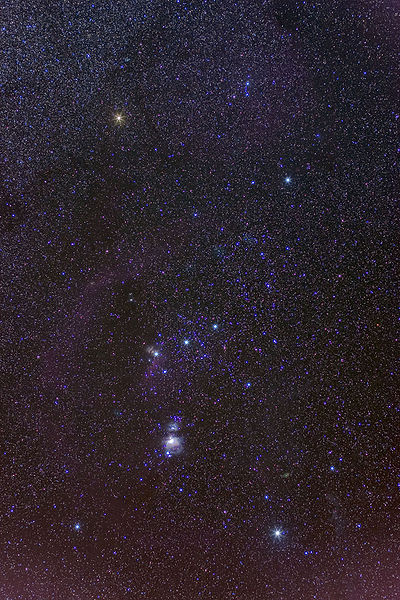|
|
 The constellation Orion, by Mouser Williams, from Wikimedia commons. Note the contrast in colour between the red supergiant Betelgeuse (top left) and the blue supergiant Rigel (bottom right). All the principal stars in Orion are extremely bright and quite distant (of order 1000 light years away): many
of the fainter "background" stars in this image are actually closer. The fuzzy patch
in Orion's sword is the Orion Nebula, a star formation region: see lecture 6.
The constellation Orion, by Mouser Williams, from Wikimedia commons. Note the contrast in colour between the red supergiant Betelgeuse (top left) and the blue supergiant Rigel (bottom right). All the principal stars in Orion are extremely bright and quite distant (of order 1000 light years away): many
of the fainter "background" stars in this image are actually closer. The fuzzy patch
in Orion's sword is the Orion Nebula, a star formation region: see lecture 6.
|
Summary of Lecture 1 – The Night Sky
-
We observe that the stars in the night sky
- have different brightnesses
- have different colours
- By carefully measuring small changes in the positions of stars, we can determine
- the distances of nearby stars
- by observing the shift in the star's position caused by our motion around the Sun (its parallax)
- note that these shifts are very small: the nearest star is just over 4 light years away and moves 1.5 arc seconds (that's about 1/2000 of a degree)
- the masses of some nearby stars which are in gravitationally bound pairs
- by observing the orbital motion of the stars about one another, and therefore working out the gravitational forces
- note that these binary systems are very common, but not all can be used in this way: we need to be able to see both stars, and the orbital period needs to be short enough for us to observe it (a period of 2000 years is quite possible, but not very helpful!)
- If a star's distance is known from parallax, we can use its measured (apparent) brightness to work out its intrinsic
(absolute) luminosity
- Apparent and absolute brightness are often expressed in terms of magnitude
- smaller magnitudes correspond to brighter stars
- one magnitude brighter means 2.5 times as bright, two magnitudes is (2.5)2, etc. (the magnitude scale is logarithmic)
- bright stars (e.g. Vega) have apparent magnitudes around 0; the faintest stars we can see in a dark night sky (no streetlights or full moon) have apparent magnitude 6
- note that in books and on diagrams, apparent
magnitude is given the symbol m, whereas absolute
magnitude is given the symbol M; also, apparent magnitudes
viewed through particular colour filters are sometimes referred to by the filter
name (thus V would be an apparent magnitude as viewed through the
V (yellow-green) filter)
- From our survey of nearby stars, we conclude that the Sun is
- much brighter than average, although not as bright as the (rare) stars which shine brightly in our night sky
- more massive than average, although not as massive as the bright stars of the night sky
Web links
Go back to main page
Go on to Summary for Lecture 2
|
Hicks Building, Hounsfield Road, Sheffield S3 7RH, UK
|